South Newington, Oxford (†Oxfordshire) C.15
Passion Cycle
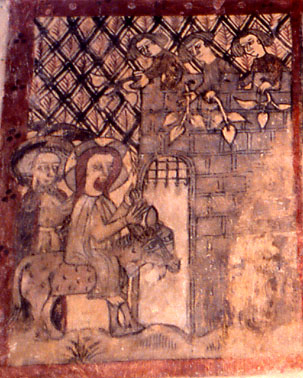
It will be instantly obvious to anyone familiar with the earlier wall paintings at South Newington, such as the Virgin and Child, the Annunciation the Martyrdom of Thomas Becket and St Margaret, that this Passion Cycle, dating from the second half of the fifteenth century, does not begin to compare with them for quality. It is, however, not without interest.
Some scenes are well preserved, others too dilapidated to include here, but at the left is an intact Entry into Jerusalem. The painstakingly painted wall of the city has a spiked portcullis over its arched opening, and on its castellated top stand three people, all in the act of throwing down branches of foliage into the path of the approaching donkey, on whose back Christ rides. A figure, probably also paying homage, stands or walks near the gates.
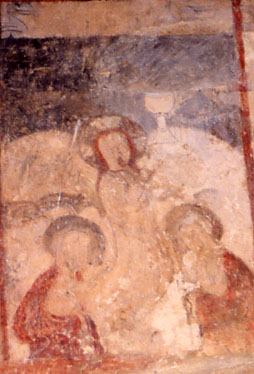
Immediately following this scene is the Agony in the Garden (detail, right), a scene found only seldom. There are a couple of others – a touching example at Ford in Sussex and another at Crostwight in Norfolk. The Crostwight painting is undoubtedly aesthetically superior, but it cannot boast the literalised chalice or cup of the synoptic Gospels that is so prominent a feature here. Christ, the tallest figure in the scene, kneels in the centre, either holding out the cup or gesturing towards it. Two figures in red mantles below him are shown in attitudes suggesting sleep, and there may have been others behind.
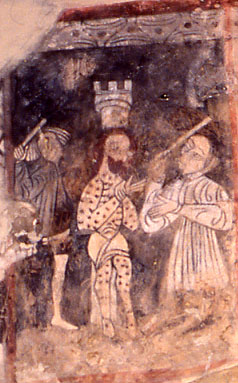
Two scenes, one badly damaged, the other virtually invisible, follow. They were almost certainly the Betrayal and the Arrest in Gethsemane and they are followed by a clear scene of the Buffeting (below, left). Christ stands centrally, already covered in what seem to be gouts of blood (any attempt to co-ordinate Gospel chronologies invariably fails at around this point), while two men beat him with staves. The top of the classical column to which he is bound shows above his head. Only the face of the man on the right is clear in detail, but it seems to have the distorted features regularly found on torturers and visible in some of the other Passion Cycles in the table below, as well as elsewhere in these pages.
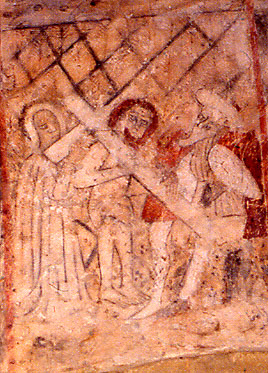
The next scene is the Road to Calvary, (right) and it features Christ’s mother Mary helping him to carry the Cross. This same detail might be included in another Passion Cycle, at Little Easton in Essex, but it is indisputably clear here.
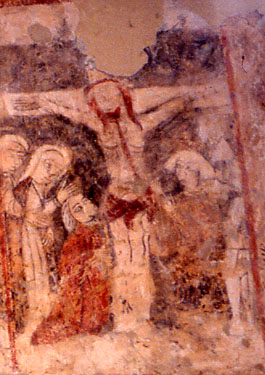
A much more puzzling feature is the presence of a man in a round, turban-like hat on the right, apparently seated, with one pointed, black-shod foot extended forwards and the other backwards, propped on the toe with heel raised, below his seat. One possibility is that this is the man, variously called Ahasuerus, Cartaphilus, or Malchus¹ who supposedly refused to let Christ rest on his doorstep and subsequently passed into folklore as the ‘Wandering Jew¹, but it should be stressed that this is the purest speculation, based mainly on the generally ill-intentioned facial appearance and expression of the man (the oddly-shaped, curving beard is conspicuous) and his seated position in what is in effect the public street. At least one other figure – the owner of the leg emerging from the skirt of a short red tunic – is standing behind.
The scene is followed by one of the Crucifixion (left). The Two Thieves are not here, but two women stand at the left, the one nearest the Cross certainly the Virgin Mary. Another figure, in a red robe, kneels, but it is difficult to be sure whether this is St John or Mary Magdalene. On the right a man with the short straight hair found elsewhere in this cycle is probably Longinus (very close scrutiny shows him to be holding something, probably the lance), and at least one other obscure figure in armour stands further right.
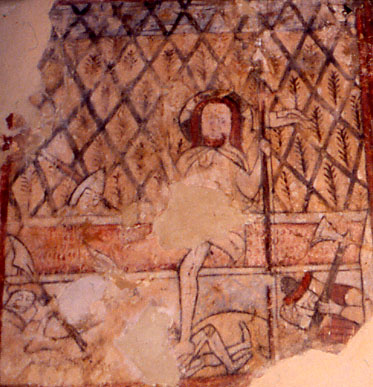
Two further scenes, too damaged and obscure to include, follow; they are probably the Deposition and the Entombment, and they in turn are followed by the last clear scene, the Resurrection (right). Four soldiers, all at least partly visible, are shown in sleeping postures around a rectangular sarcophagus as Christ steps out of it, holding the Vexillum banner of the Resurrection.
The trellis pattern visible here, with plant sprigs in the lozenge shapes, probably once formed the background to most, if not all, of the scenes (it shows particularly well in the Entry into Jerusalem). There are other ambitious attempts at pattern elsewhere – the elaborate upper border in the scene of the Buffeting, for example – all of which suggest to me that Cycle has been copied from, or closely based on, a series of manuscript paintings.
The fifteenth-century painter at South Newington certainly had more determination than graphic talent, but this honest, rustic work is none the worse for that. And the donkey in the Entry into Jerusalem is quite irresistible.
Website for St Peter ad Vincula, South Newington
¹ He is thus sometimes conflated with the High Priest’s servant, unnamed in the Synoptic Gospels but identified as Malchus in John 18:10. The bible is otherwise completely silent about the existence of this man, although ingenious attempts have been made to interpret Christ’s enigmatic utterance in Matthew 16:28 – “…there be some standing here, which shall not taste of death, till they see the Son of man coming in his kingdom” as a reference to him. Totally fictitious as the Wandering Jew is, one of the many tales that clustered around him was that he was a shoemaker, and was sitting at work outside his shop when Christ passed by, which would explain his presence and posture here. He may in fact be elsewhere in these pages. Malchus, whose ear Peter cuts off at Fairstead has a similarly exaggerated chin or beard. There is a sober and scholarly online article about the Wandering Jew in the searchable Jewish Encylopedia. But be careful with other websites – Google’s warning about offensive content should be heeded.